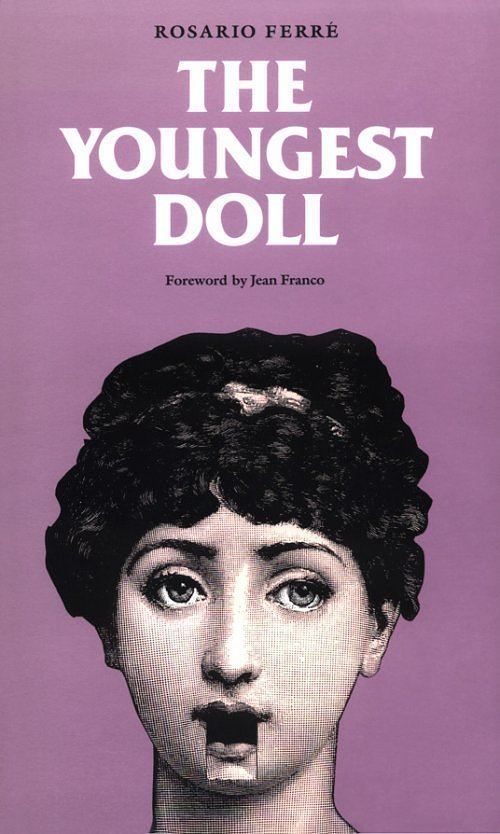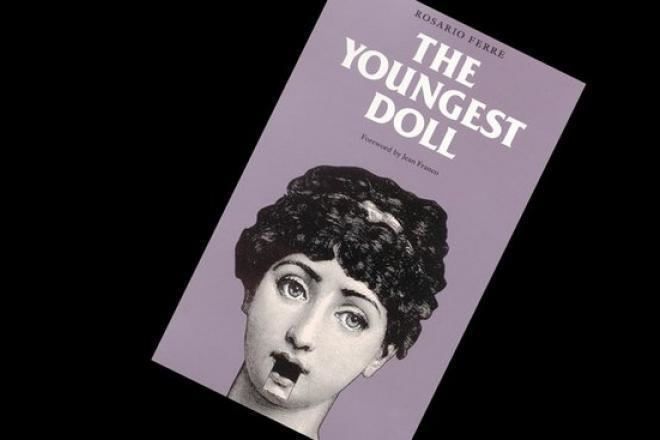 | ||
Rosario Ferré books Papeles De Pandora, The youngest doll, La casa de la laguna, The house on the lagoon | ||
La muñeca menor (The youngest doll) is a short story by Rosario Ferré published in 1976. This story falls under the genre of magical realism. According to critic Cynthia Sloan, "One of the lucid strategies that Ferré employs to challenge the conventional misrepresentation to introduce the presence of dolls in the literal, as well as the figurative sense, to show how the doll, being the stereotypical choice of toy for a girl, encapsulates societal expectations of behavior and appearance and therefore limits the scope of possibilities for women by continually reinforcing unrealistic ideals." The text also reflects the weakening of landowners as a result of industrialization.
Contents
La mu eca menor
Plot

As a young woman, "la tía" ("the aunt"), would often bathe in the river. One such day, she has an accident while swimming in which she was bitten on the calf by a chágara, a fictitious aquatic river prawn. A doctor inspects her wound and determines that the chágara has nested inside the calf wound. The wound does not heal and her leg becomes swollen and enlarged, and the doctor continues to provide treatment for her. As the years go by, the aunt, though beautiful and wealthy, is ashamed of her disfigured leg and abandons the prospect of marriage, instead focusing on raising her nine nieces. For each of their birthdays, she creates a doll for each one of them, and over the years, perfects the dolls to resemble each niece. As each niece grows and is sent off to get married, the aunt creates one last doll for each and states "Aquí tienes tu Pascua de la Resurrección" ("Here is your Easter Sunday").
As the doctor continues to treat the aunt over the years, he brings his son, who is also studying to become a doctor. His son examines her leg and later, tells his father that her leg could have been cured long ago. However, his father reveals to him that by exploiting the aunt's wealth for his regular visits, he was able to pay for his son's education, telling his son that "I wanted you to see the prawn that has paid for your education these twenty years." The doctor retires, and his son becomes the aunt's new physician, continuing to exploit her condition for his gain. Eventually, the young doctor asks the youngest niece for her hand in marriage, and she accepts. The doll that is made for the youngest niece is made of porcelain, honey, and has diamond earrings for eyes. For the last time, the aunt sends them off saying, "Here is your Easter Sunday."
Once married, the young doctor immediately moves his wife, the youngest niece, to an ugly concrete building, a strong contrast from the luxury she has known. The doll is placed in their new home on top of the piano. The young doctor orders his new wife to sit on the balcony, as evidence for all to see that he married into high society. After some time, as the youngest niece remains on the balcony, the young doctor decides to sell the doll's diamond eyes. He scrapes them out of the doll's face and buys himself a pocket watch. The doll and the youngest niece close their eyes on that day. One day, the young doctor desires to sell the doll's porcelain skin, and sees that the doll is missing and his wife explains that ants must have found it and eaten it, given that it was filled with honey. Over time, the doctor observes that his wife does not age. One night, he checks on her and sees that her chest does not rise and fall as it would if someone were breathing. Listening into her chest, he can hear the sound of the river within her. Her eyelids then open to reveal lifeless eyes, from which begin to emerge the antennas of angry chágaras.
